Premature atrial contractions
- Usually idiopathic and benign
- May be due to catecholamine excess, electrolyte abnormalities, lines, hypoxia, or acid base disturbances
- Generally no treatment is needed
- Should correct lytes if abnormal and evaluate lineplacement
- Typically resolve w/ time
Premature ventricular contractions
- More worrisome than PACs
- Seen w/ electrolyte abnormalities, hypoxia, hypocalcemia, catecholamine excess
- Monitor how frequent, number in a row, unifocal or multifocal
- Treatment depends on frequency, rate, associated conditions, and if a structural or functional change
- Always correct lytes and evaluate line placement
Bradycardia
- If asymptomatic, usually no treatment
- Acute treatment: Atropine, isoproterenol, or temporary pacing
- Chronic treatment: Pacing
Heart block
- 1° heart block in absence of heart disease usually does not progress
- Watch 2° heart block closely as may develop into worsening heart block
- Avoid meds which slow AV conduction (β blockers Ca Channel blockers, Dig)
- Tx as above for bradycardia
Supraventricular tachycardia
- Follow PALS guidelines!
- If adequate perfusion
- Vagal maneuvers (ice to face, knees to chest)
- Adenosine
- Give 0.1 mg/kg IV/IO (max first dose 6mg) May double and repeat second dose (max 12 mg)
- Give as rapid bolus followed by flush Try to use central line or IV closest to heart
- Consult cardiology
- Consider antiarrhythmic meds
- esmolol, amiodarone or procainamide
- Consider overdrive pacing
- Cardioversion
- Use 0.5 to 1 J/kg, may increase to 2 J/kg if initial dose is ineffective
- Use sedation if possible (Etomidate 0.1mg/kg is a good choice, may repeat dose as needed)
- If inadequate perfusion
- 1) IMMEDIATE Cardioversion
- Use 0.5-1 J/kg, may increase to 2 J/kg if needed
- Do not delay cardioversion for sedation
- 1) IMMEDIATE Cardioversion
Junctional ectopic tachycardia (post-operative)
- Correct acidosis and electrolyte abnormalities (Mg, K, Ca)
- Mild hypothermia (35 degrees Celsius)
- Reduce inotropic agents (NE, Epi) as able
- Make sure adequate pain control (sedation)
- Consult cardiology
- Slower rates may not need treatment (<170 bpm)
- For higher rates, consider atrial overdrive pacing (higher rates may gain AV synchrony thus causing improved filling)
- Consider antiarrhythmic medications (amiodarone, procainamide)
- Chronic treatment: Pacing
Premature atrial contraction

- QRS appears early
- P wave different morphology
- Incomplete compensatory pause
Premature ventricular contraction

- Differing morphology QRS w/o proceeding P wave
- Full compensatory pause
- Typically large T wave w/ opposite polarity of QRS
Supraventricular tachycardia
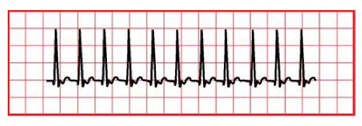
- Sudden start and stop
- Narrow complex
- Usually do not see P wave (may be retrograde P wave in T wave)
- No HR variability
1° AV block
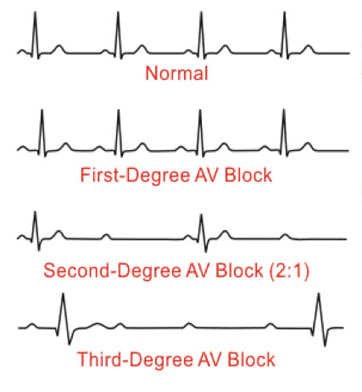
- PR prolongation >0.2 sec
2° AV block
- Mobitz Type I (Wenckebach)
- Increasing PR intervals prior to dropped QRS
- Mobitz Type II
- Intermittently non-conducted P waves not preceded by PR prolongation
3° AV block
- No apparent relationship between P waves and QRS complexes
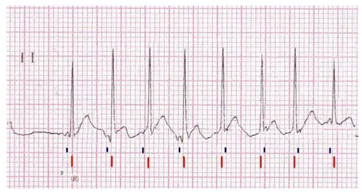
*Atrial activity is marked by blue and ventricular activity is marked by red. Note that some P waves follow the QRS = dissociation!
Junctional ectopic tachycardia
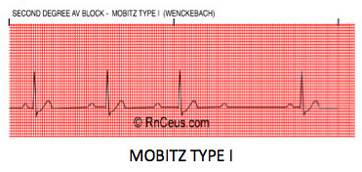
- Narrow complex tachycardia
- P waves not discernible, are dissociated from the QRS, or show retrograde conduction
- Typically "ramps up and ramps down"
- No HR variability
|
FIRST LETTER |
SECOND LETTER |
THIRD LETTER |
|
Chamber paced |
Chamber sensed |
Mode of response |
|
V = ventricle A = atrium D = dual chamber |
V = ventricle A = atrium D = dual chamber O = none |
I = inhibited T = triggered D = triggered & inhibited O = none |
Terminology
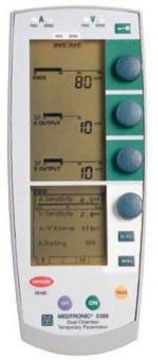
Ability of pacemaker to cause depolarization of heart chamber
Sensitivity
Ability of pacemaker to detect intrinsic cardiac activity
The lower the number on the dial = the more sensitive the pacemaker
Important
If pt is being paced, always be sure to check for appropriate capture (pacer spikes followed by an electrical response).
The pacer mode should always be on the monitors if pt is paced.
If you suspect pacer has lost capture, notify fellow immediately and contact cardiology if needed.
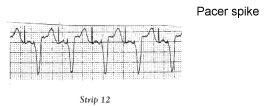
PATIENT
Atrial wires = White
Ventricular wires = Blue
Information to obtain
- Details of repair… Ex: size of shunt, where incision was made, valve-sparing procedure, etc
- Complications during repair (arrhythmias, bleeding, etc)
- Post-operative TEE findings… Ex: gradients, residual VSD leak, valve regurg
- Cardiopulmonary bypass time and aorta cross clamp times…longer times tend to have more complicated post-op courses
- Specific post-operative parameters or goals… Ex: SBP <70 to prevent any tension on sutures or leak at anastomosis
- Specific lines and tubes… Ex: IJ, art lines, MTs or CTs
- Trends during case… Ex: what CVP did pt tolerate, BP trends, heart rate ranges
- Blood product administration… Ex: FFP, plts, etc
- Any worrisome labs… Ex: coags, lactate
- Airway management… Ex: easy intubation, reasons why they did not extubate
- Rhythm problems intra/postoperatively. Pacing yes/no
Helpful hints w/ post-op orders
- Tina Davenport usually takes care of all orders… go assess pt!
- For big cases on bypass, IVF are written for 1/2 maintenance b/c we try to account for
- Cardiac gtts
- Fluid boluses or blood product administration
- SIRS & capillary leak
- IVF often are D5W so pay attention to pt's Na. Will need to adjust once Na is in the normal range.
- Hourly labs need to be drawn initially, adjust lab frequency as needed as pt stabilizes
- Please check over orders. Make sure the morphine dose, tylenol dose, etc are appropriate.
- Goal K > 4, iCa > 4, Mg > 2, replace as needed.
Important trends to follow
- SVO2 — good indicator of oxygen extraction,changes in trends may indicate change in pt status>
- High SVO2 — inadequate extraction
- Low SVO2 — inadequate oxygen delivery
- Cerebral & renal somenetics — also indicator of oxygen extraction
- Lactate — <2 is normal, watch trends!
- Hct — Many repairs require higher HCT to maintain good oxygen delivery
- CVP — marker of volume status, important b/c some repairs require higher CVP but may also indicate concern for issues like tamponade
- Vital Signs — Changes in HR may be a subtle sign of an arrhythmia
- UOP and I/O balance
- Chest, mediastinal, and peritoneal drainage
Important exam findings
- Murmurs — any changes in quality, new murmurs
- Edema/ wts — are they volume overloaded or dry
- Hepatomegaly — worsening CHF?
- Perfusion — warm, cool, clamped down
- Drainage from tubes — chylous, increased output, bloody
The fellow and staff are there to help
Please don't hesitate to ask questions
- Inadequate tissue perfusion → anaerobic metabolism → accumulation of lactic acid → metabolic acidosis
- If acidosis is unrecognized → cell death, organ dysfunction, multi-organ system failure, and DEATH
- Goal is to improve tissue oxygenation by increasing oxygen delivery and decreasing oxygen demand
- Treat underlying process
- EARLY RECOGNITION IS KEY!!!
- Requires high index of suspicion
- Tachycardia and tachypnea often 1st sign
- Hypotension is a late finding in pediatrics
Etiology of shock
- Hypovolemic - characterized by inadequate circulating intravascular volume, ex: hemorrhage, fluid loss
- Cardiogenic - characterized by myocardial dysfunction, ex: arrhythmias, cong heart disease, myocarditis, cardiomyopathy
- Obstructive - characterized by inability to produce adequate cardiac output despite normal intravascular volume, ex: tamponade, pneumothorax, outflow obstructions
- Distributive - characterized by inadequate distribution of fluid volume, ex: anaphylaxis, spinal cord disruption, severe sepsis
General treatment principals
- ABCs - Consider intubation to decrease O2 demand
- Invasive lines often needed
- Fluid Resuscitation - If unresponsive, widen DDx!
- Vasoactive Infusions - Will provide CV support
- Sedation/Paralysis - Will decrease O2 demand
- Temperature Control
- Antibiotics
Variety of anatomic lesions not amenable to two ventricle repair (valve atresia/hypoplasia, outflow tracthypoplasia, etc)
Complete mixing of systemic and pulmonary venous returntypically at atrial or ventricular level
Aortic and pulmonary blood flow are in parallel circuits
Frequently there is an obstruction to outflow tract
Most are dependent on prostaglandins (PGE) until surgery
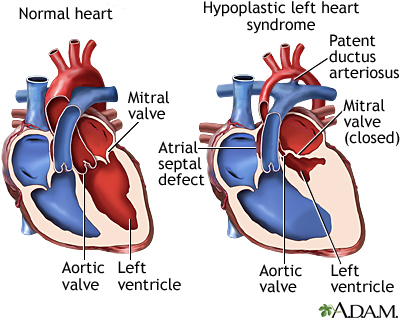
Example of one type of single ventricle preoperatively
Balancing the circuits preoperatively
Goal to provide enough pulmonary flow for adequate oxygenation (70-80%) and enough systemic flow for adequate oxygen delivery to prevent acidosis without an excessive volume load to single ventricle
Ways to increase PBF
- Alkalosis (pH > 7.4)
- Oxygen
- Nitric oxide
- Sedation/ paralysis (relaxes vascular bed)
Ways to decrease PBF
- Acidosis (pH < 7.35)
- Permissive hypercarbia (CO2 50-60)
- Subambient oxygen (nitrogen or CO2)
- Increase PEEP/ MAP
Ways to increase SBF
- Vasodilators (ex: Nipride)
- Afterload reduction (ex: Milrinone)
- Sedation/paralytics
Ways to decrease SBF
- Phenylephrine
- Norepinephrine
*PBF = pulmonary blood flow
*SBF = systemic blood flow
General goals of surgical repair
- Unobstructed systemic blood flow ( to minimizeventricular hypertrophy)
- Limited PBF ( to minimize ventricular volume load andrisk of pulm artery HTN)
- Unobstructed venous return (to minimize left atrial andsecondary pulm artery HTN)
- Minimize likelihood of pulmonary artery distortion
- Prevent arrhythmias
- Avoid AV valve regurgitation
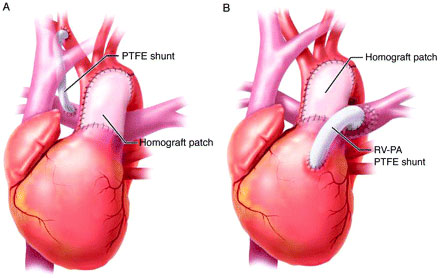
Modified BT shunt & arch repair (pulm artery to aorta anastomosis)
- BT shunt – Subclavian artery to Pulm artery
- Atrial septectomy
- Pulmonary blood flow all comes from the BT shunt
- Systemic blood flow from aorta
Norwood-sano
- Aorta and Pulm artery joined w/ patch homograft
- Sano – RV to PA conduit
- Atrial septectomy
Post-operative problems
Low cardiac output
- Typically first 24-48 hrs
- Sx: Tachycardia, hypotension, oliguria, acidosis
- May be caused by globally decreased ventricular output (poor pump performance), elevated pulmonary flow compared to systemic flow, AV valve regurg and rhythm disturbances
Cyanosis
- Pulmonary venous desaturation ( pneumothorax, pleural effusion, pulmonary edema, infection)
- Decreased pulmonary blood flow ( elevated PVR, pulm venous HTN, restrictive atrial septal defect, PA distortion, small shunt
Low SVO2
- Inadequate oxygen delivery (anemia, low CO) or increased consumption (fever, agitation, sepsis)
Elevated oxygen saturation
- Too pink, sats ~90%
- Typically has low PVR and pulmonary blood flow in excess of systemic blood flow
- May lead to inadequate perfusion, renal dysfxn, inability to wean from vent
*Concern for coronary hypoperfusion w/ BT shunt if excess pulmonary steal
Important physical exam findings
- Shunt murmur – systolic, diastolic, harshness
- New murmur – concern for AV valve regurg
- Hepatomegaly
- Edema – ascites, pulm edema on CXR
Anticoagulation is important 24-48 hrs post surgery
Primary goal of repair
Reduction of the volume work of the single ventricle and a predictable Qp:Qs (pulm:systemic) of 0.6-0.7
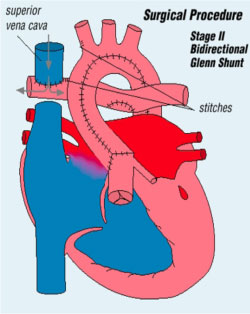
Description of repair
- SVC is divided w/ cardiac end oversewn.
- Cephalic end is anastomosed end to side w/ ipsilateral PA.
- Typically done b/w 4-9 months
Important physiology post glenn
- Pulmonary blood flow is PASSIVE!
- All SVC return must pass through lungs to reach the heart.
- Ventricular filling is not absolutely dependent on pulmonary venous return, because IVC still returns blood to single ventricle which maintains preload.
- Early extubation is key!
- Pts need anticoagulation to prevent shunt from clotting.
Post operative issues
Elevated SVC pressures
- Sx: Upper extremity plethora, edema, unexplained fussiness, full anterior fontanelle
- May have obstruction at anastomosis, distal PA distortion, or marked elevations in PVR.
- Will limit cerebral blood flow
Hypertension/bradycardia
- HTN may be caused by pain, catecholamine secretion, or intracranial HTN.
- Be cautious in lowering too quickly as may decrease cerebral blood flow.
- Bradycardia may be due to acute reduction in volume load of single ventricle, intracranial HTN, or injury to sinus node.
Hypoxemia
- Consider pulm venous desat, decreased pulm blood flow, or low SVO2 (see previous page).
- Important to consider pulm AV malformations as additional cause of pulm venous desat.
- Decompressing venous collaterals, baffle leak, or contralateralSVC may also cause decreased pulm blood flow.
Chylothorax/pleural effusions
- Common post-op problem. Follow output closely and replacement of lytes and immunoglobulins is key.
Description of repair
Extracardiac conduit connects IVC to PA
Fenestration may or may not be used to serve as a “pop-off” valve to minimize central venous pressure and allow cardiac output in setting of increased mean pulmonary artery pressure.
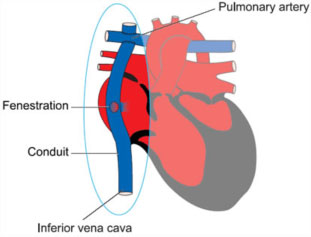
Post operative management directed towards optimizing cardiac output at the lowest central venous pressure possible.
Post operative issues
Mechanical ventilation
Positive pressure ventilation may adversely affect PVR and ventricular filling. Early extubation important.
Low cardiac output
May be caused by 1) inadequate preload, typically due to hypovolemia, 2) elevated PVR, 3) anatomic obstruction in the systemic venous pathway, or 4) pump failure.
*Low cardiac output in face of high LA pressure is bad sign!
Arrhythmias
Poorly tolerated, especially loss of AV synchrony.
Commonly junctional ectopic tachycardia (JET), sinus node dysfunction, or atrial flutter.
Pacing may be needed!
Cyanosis – as previously described in stages 1and 2
Effusions/ascites
Typically most frequent postop problem prolonging hospitalization. Fenestrations and modified ultrafiltration have been helpful in reducing effusions.
Drainage catheters and appropriate replacement of volume, electrolytes, protein, and immunoglobulins is key.
Thrombosis
Following surgery, at risk for venous thrombosis and central nervous system complications.
Anticoagulation is important.
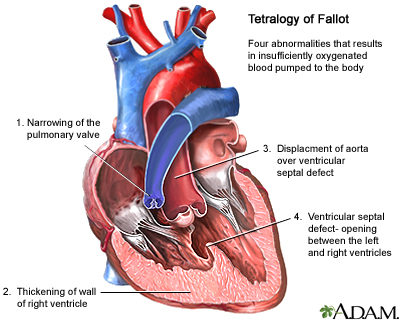
- Pulmonary Stenosis
- RV Hypertrophy
- Overriding aorta
- VSD
“Tet Spells”
- Agitation/irritability, hyperpnea, profound cyanosis, syncope
- Dynamic obstruction to pulm blood flow
- Tx: Oxygen, volume, sedation, positioning (knee-chest/squat)
- Other options if above fail: Bicarb, phenylephrine
Pre-operative pathophysiology
- Physiology dependent on pulmonary blood flow
- Minimum obstruction : L → R shunt through VSD
- Symptoms: Pulm overcirculation, CHF
- Severe obstruction: R→ L shunt
- Symptoms: Hypoxic, sat 70-80%
- Balanced obstruction: Enough PS to prevent over-circulation, sats ~90%
Key Questions to ask surgeon
- How was the RVOT repaired? (transannular vs. valve sparing)
- What did the RV and PAs look like? Any abnormal anatomy?
- Post operative TEE findings?
Post-operative issues
- Residual VSD – May have hemodynamic instability, high atrial pressures
- RV Outflow tract obstruction – Usually causes more long term issues, ventricular arrhythmias, and possible need for repeat repair
- RV Dysfunction – Consider if incision was made in RV or pulm regurg
- Arrhythmias – JET, ventricular ectopy, complete heart block
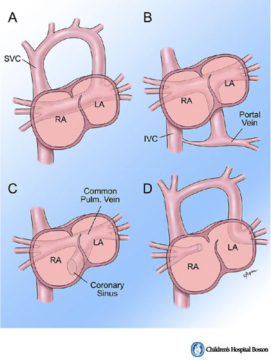
Supracardiac (A)
R & L Pulmonary veins (PV) join in a confluence posterior to LA & are connected via ascending vertical vein to innominate vein which drains into SVC (MOST COMMON)
Infracardiac (B)
Confluence of PV drains via descending vertical vein to portal venous system to IVC
Cardiac (C)
R & L PV drain into a dilated coronary sinus or directly into RA
Mixed pattern
4 PV drain into more than one venous structure (ie. R PV to RA while L PV into vertical vein)
Pathophysiology
Obstructed Veins: Pulmonary venous hypertension is seen w/ resultant pulmonary edema. Reflex pulm arteriolar vasoconstriction and pulm HTN are seen w/ resultant right heart failure.
Unobstructed Veins: Pulm venous return is to systemic venous circulation and blood from both venous systems is mixed. Systemic cardiac output is maintained by R à L shunt at atrial level.
Post-op complications
Low cardiac output
Previously dilated R sided structures influenced LA and LV, which made LV less compliant. LV may need high filling pressure post-operatively.
Respiratory insufficiency
Fulminant pulmonary edema prior to surgery + cardiopulmonary bypass may lead to severe respiratory compromise.
Pulmonary hypertension
Due to medial hypertrophy of pulm arterioles, pulm HTN occurs in ~50% of pts. Significant risk factor for death in immediate post-op period.
Need to rule out residual pulm venous obstruction by echo if problems post-operatively.
Arrhythmias
Usually supraventricular, occur in ~20%.
***Import to know that lowering of PA pressures and increased pulmonary blood flow post-operatively can lead to increased preload to L side of the heart leading to a bad cycle of increased LA pressure, increased PA pressure, decreased LV compliance, and increased LA pressure which all exacerbate pulm HTN!
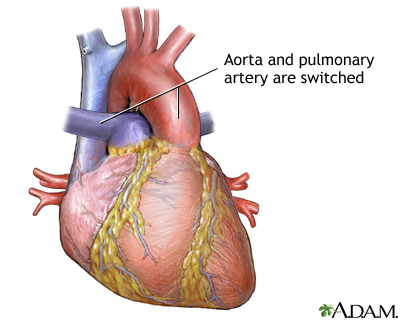
D-TGA is when aorta arises from RV and RA arises from LV. Most common form of transposition.
Important associated defects for surgical planning are malalignment septal defects.
Anterior (rightward) defects are associated w/ varying degrees of overriding of pulmonary annulus onto RV.
Posterior (leftward) malalignment defects are associated w/ varying degrees of subpulmonary stenosis, annular hypoplasia, or pulmonary valvar atresia.
Important pre-op physiology
Dominant problems are poor oxygen delivery and excessive R and L ventricular workload.
MUST HAVE AN INTRACARDIAC (PFO, ASD, VSD) or EXTRACARDIAC (PDA) shunt to survive – may need emergent balloon atrial septectomy if pt not responding to prostaglandins!
Poor mixing is often seen by low pO2, elevated pCO2 (despite good chest movement/ ventilation) and a metabolic acidosis! Important because pt has severely decreased effective pulmonary and systemic flows. Need to ensure mixing and maximize oxygen delivery!
Surgical repairs
Arterial Switch – Great vessels are transected, coronaries inspected and translocated to new aorta, septal defects are repaired.
Rastelli – Used mostly for TGA w/ large VSD and extensive LVOTO.
LV output directed to aorta by intra-ventricular patch tunnel technique and RV is connected to PA by extracardiac valved conduit.
Post-operative issues
1) Arrhythmias – especially b/c of transfer of coronary arteries
2) LV dysfunction – may be due to coronary insufficiency or “unprepared” LV. LV may be poorly compliant following Switch. Need to give volume slowly as acute change in preload may increase LA pressure, cause pulm edema, and decrease cardiac output.
3) Rule-out any residual stenosis or ASD/VSDs (if initially present). Rule out conduit obstruction or branch PA distortion if Rastelli was performed.